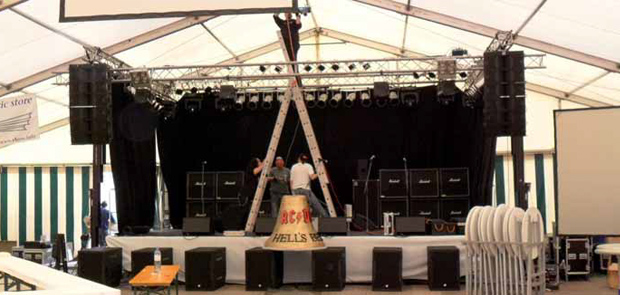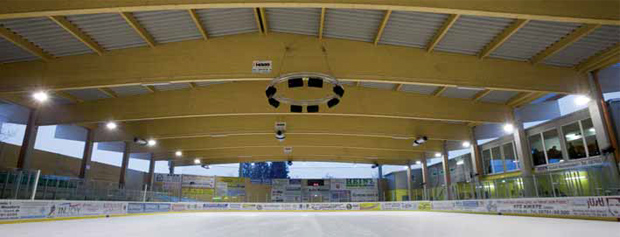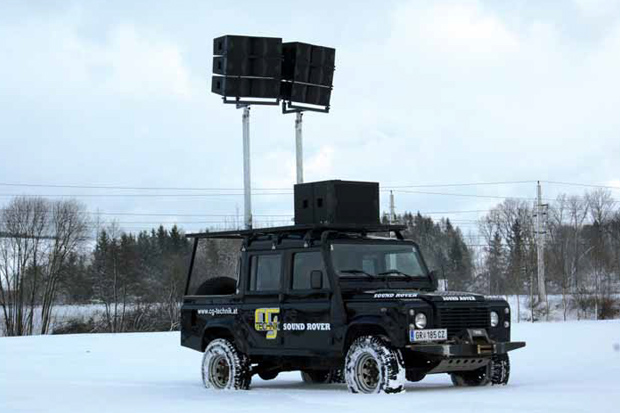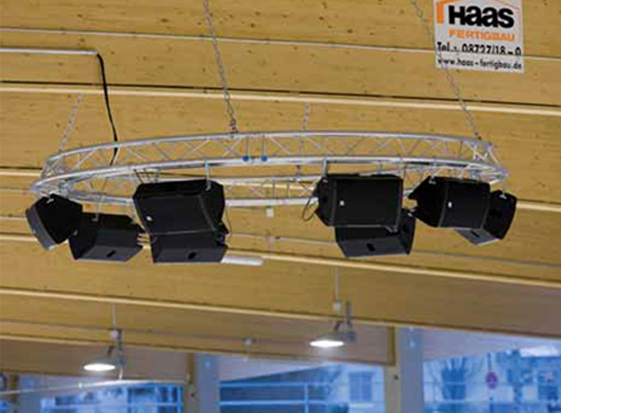LDVA4 – Economical and compact – Test Report by ispmusica.com
The most cutting edge line arrays on the market. This month…ADAM HALL
 VUE LINE ARRAY: ECONOMICAL AND COMPACT FROM THE PREMIUM LD-SYSTEMS LINE SERIES WITH V 215B SUBWOOFER
VUE LINE ARRAY: ECONOMICAL AND COMPACT FROM THE PREMIUM LD-SYSTEMS LINE SERIES WITH V 215B SUBWOOFER
And still counting! Our March issue contained a line array special, in which we presented the most ground breaking and cutting edge systems from various brands that are currently making waves in the professional audio sector. Subsequently, we analysed each of these systems in depth…This month, it is the turn of the LD VA4 from Adam Hall, a line array that adapts to any type of situation, offering the best sound coverage for all kinds of events. And best of all: It’s compact and affordable! What more could you ask for? Keep reading to find out more.
The Adam Hall Premium series consists of four multifunction 8″, 10″, 12″ and 15″ boxes, three subwoofers measuring 1×15″, 2×15″ and 2×18″, in addition to two Line Array systems. The larger system is 2×8″ in size, with the smaller measuring 2×4″. In this article, we analyse the latest model, named the VA4, together with the V 215B 2×15″ subwoofer. Measuring 480 mm in width and 139 mm in height, the VA4 system is a compact Line Array that is normally used for intimate performances in clubs or as a fill for large size applications.
t can also be used as a side fill or drum fill when a large amount of coverage and precise positioning is required. The systems, developed in Germany, are manufactured in the Far East and are, for the most part, fitted with their own construction chassis. An overhang system with U-shaped clamp, in addition to a stack kit on the ground are available as assembly accessories. The U-shaped clamp allows for the assembly of an array with a maximum of four VA4s and adapts to any standard speaker support.  The overhang structure weighs 3.8 kg and is very light, is BGVC1 certified and supports up to 16 VA4 units. For small Line Arrays in particular, there is the option to stack the boxes on the floor directly above the subwoofer using an integrated assembly system in the V 215B subwoofer for a maximum of six VA4s that can be assembled either vertically or in a tilted position. Likewise, for the 480 mm wide subwoofer, only three assembly supports are required.
The overhang structure weighs 3.8 kg and is very light, is BGVC1 certified and supports up to 16 VA4 units. For small Line Arrays in particular, there is the option to stack the boxes on the floor directly above the subwoofer using an integrated assembly system in the V 215B subwoofer for a maximum of six VA4s that can be assembled either vertically or in a tilted position. Likewise, for the 480 mm wide subwoofer, only three assembly supports are required.
Together with the 1.06 m high subwoofer, it is possible to position a VA4 array in small venues in order to ensure it is at a suitable height above the audience. Amongst other accessories for mobile applications, the VA4 system has a transport flightcase into which up to six boxes can be inserted.
 VA4
VA4
Let’s look at the VA4 system in more detail. The box, that weighs just 9.6 kg, is manufactured using 15 mm plywood and is covered by a resistant protective lacquer. The front part is protected by a solid grate, coated with a thin layer of foam. The overhang mechanism is integrated within the baffle; as a result, only two lock pins are required for the front part and one for the rear part. The angle between the speakers can be adjusted using the rear part. A choice of 0, 2, 4 or 6 degrees is available. The maximum angle of six degrees is very little for such a small system, especially when, according to WST (Wavefront Sculpture Technology), the angle could reach up to 20°. The most interesting aspect is within the VA4, where there are three advanced compression motors. Two 4″ subwoofers fitted with a Kevlar cone and a neodymium magnet and a 1″ treble driver, also equipped with a neodymium magnet, operate with a small waveguide. The control is active, i.e., there is no internal passive filter.
Straight in front of the tweeter is the protection condenser, which prevents the tweeter breaking should the box be accidentally connected incorrectly. The active control may appear unusual in such a small speaker, but it offers impressive advantages at no extra cost. Given that amplifier channels are usually highly utilised by Line Arrays, the cost calculation will include one amplifier channel with four or even eight passive crossover channels as standard. Regardless of the cost, the active mode offers other advantages: the tweeter and subwoofer can be synchronised accurately, the individual channels can be filtered with precision and, importantly, the limiter can accurately separate both channels depending on the speaker, whereas passive systems always have some form of drawback.
When measuring the VA4s, the two channels of a single box were measured separately. In Figure 1, the corresponding results for frequency and sensitivity are shown at a power input of 1 W and a nominal impedance of 16 ohms at a distance of 1 metre. The two 4″ subwoofers reach around 84 dB at 100 Hz and then steadily increase until reaching a maximum value of 92 dB at 1.6 kHz. At first sight the values seem quite low; however, it is worth remembering that the 4″ chassis is relatively small. On the other hand, the impedance curve offers a very solid reading of 16 ohms, where minimum impedance is 16 ohms. The resonance frequency with regard to bass reflex is 78 Hz; as a result, the VA4 can be used up to 70 Hz without risking excessive diaphragm movement, which is suitable for working in Full Range. The tweeter is a very rich compression motor, which offers a frequency curve of 100 dB, with the possibility of reaching up to 1 kHz. However, the resonance of the compression motor at 1.5 kHz is significantly higher, and the subwoofer should only be cut at 2 kHz.
V 215B SUBWOOFER AND AMPLIFIER
Compared to the VA4, the V 215B subwoofer is a much larger and heavier speaker, at 2×15″ weighing almost 80 kg. Two chassis work as a direct radiation system in a large bass reflex box, with outer dimensions of 1,060 x 475 x 620 mm. The compression motors used contain 4″ coils and ferrite magnets that, although they are significantly heavier than the neodymium alternatives, in high power subwoofers they demonstrate better performance with regard to temperature, given that the heat capacity of the magnet is much higher. Externally, the chassis is made of 18 mm plywood and is as solidly designed as the VA4. Amongst its special features are the following: resistant protective lacquer, integrated side handles, a solid front grate and layer of foam, optional wheels on the rear part and integrated slots to insert the feet of other boxes during stacking. Electrical connection is the same as for the VA4, by means of NL4 connectors with LINK connection. With the VA4, the use of a V 215B is recommended for every four VA4s. When considering the results of the measurements of the V 215B as a unit stated below, without the controller, it is evident that we are dealing with a significant weight from an acoustic point of view.
The V 215B has good features from 30 Hz and at 40 Hz it reaches a sensitivity of 95 dB, that then rises in a uniform fashion to almost 100 dB at 200 Hz. The bass reflex system is adjusted to 34 Hz, with large sized tunnels that allow for a greater level with a lower level of port compression. LD-Premium offers a comprehensive range of racks for amplifiers and controllers. In stereo configurations, the four VA4s at each side connect to an SP4K amplifier for low frequencies and an SP1K8 amplifier for high frequencies. An additional SP4K amp may be required for the V 215B subwoofer. If two subwoofers are used simultaneously on each side, offering an output of 2 ohms, the use of a 2 x 3 kW and 2 ohms SP6K amp is recommended. As a controller, the two input and six output DPA-260 (of the same brand) can also be used.

MEASUREMENTS
In Figure 5, the frequency results for the controllers are shown, both for the VA4 in Full Range mode and for the V 215B subwoofer. The VA4 cuts out at around 1.9 kHz; this has been shown to be feasible in practice. With the subwoofer, it cuts out at 120 Hz which notably reduces the strain on the VA4. If you would like to know how the assembly works, see the VA4 performance in Figure 6. If you only intend on using the VA4, for example, as a front fill to cover the front part of the stage, use the “single box linear” controller function, as shown in Figure 5. When combining several VA4s in an array, two additional filters are required to equalise the array. The light blue curve shows the response of a four-box array with a curve angle of 3×0°.
The three orange coloured curves show the response with a variable angle of 3×2°, 3×4° and 3×6°. As a result, the entire system operates as a single box and also as an array with equalisers for control purposes that can adapt, if necessary, to almost any controller. To use the Full Range mode of the VA4, the lower cut-off frequency is 74 Hz, and 35 Hz for the subwoofer. The phase response and the group delay curves of the two variants are shown in Figures 7 and 8. Given that the subwoofer uses another secondary level high pass electronic filter, the increase in the group delay to a maximum of 28 ms represents an accurate response of the low frequencies. The spectrogram of the VA4 shows resonances slightly above 500 Hz and 1.2 kHz, which can also be seen in the frequency response and probably the box resonances. The maximum level measurement was performed with a four-box array with and without subwoofer, reflecting a small standard configuration. If we focus primarily on the VA4, in its operational range for subwoofers, it reaches 120 dB, increasing to 130 dB at 2 kHz.
With regard to the 2×1 power amplifier and sensitivity curve, 4 kW for the subwoofers and 2×600 W for the treble speakers, the subwoofers are restricted, mainly due to the controller limiter. Another indication is the overlap of the maximum SPL curves for a THD of 3% and 10% throughout the entire frequency range. Only at above 1 kHz do the curves clearly separate with a difference of 10 dB. The subwoofer clearly demonstrates a maximum SPL of 130 dB, which it maintains even at the highest low frequencies. As a result, under certain circumstances, a V 215B is sufficient, even for an eight-unit VA4 array.
DIRECTIVITY
In a VA4 design with two adjacent 4″ subwoofers and a cut off frequency of 2 kHz, it is easy to predict that the 120° standard horizontally will not be uniform. As can be seen in Figure 11, from 800 Hz the isobars become narrower, extending up to approximately 2 kHz and 50°. Then, the tweeter is activated and the isobars start to open again. However, the opening angle does not remain constant. The -6 dB isobars stretch from 160° to 80°.
 Vertically, the Line Array elements display the standard continuous stretching from low to high frequencies. At approximately 12.5 kHz, the above mentioned continuous progression of the isobars starts and is later broken, which is demonstrated in the measurements of a four-unit array with angles of 0, 2, 4 and 6 degrees between the boxes. At an angle of 6°, the first problems with regard to coupling can be seen between the tweeters.
Vertically, the Line Array elements display the standard continuous stretching from low to high frequencies. At approximately 12.5 kHz, the above mentioned continuous progression of the isobars starts and is later broken, which is demonstrated in the measurements of a four-unit array with angles of 0, 2, 4 and 6 degrees between the boxes. At an angle of 6°, the first problems with regard to coupling can be seen between the tweeters.
SOUND TEST
For the sound test, two systems of three VA4s and a subwoofer with its corresponding amplifier rack were built in a test chamber. The variants with and without the subwoofer were tested. The VA4 Full Range mode variant was so convincing for the low frequency range that even the Adam Hall Product Manager present at the test session was surprised and approached the speakers to listen to the subwoofers. The 70 Hz high pass filter appeared to have been selected optimally, making it possible to create a pleasing sound in the Full Range reproduction, even though the limiter may have to intervene in the LDVA4 System at times.
Obviously, at higher levels, the VA4 reaches its natural level. Combined with the subwoofer, VA4 operation is much more impressive and is also equipped with a suitable support for the deepest low frequencies. It is therefore suitable for various applications, such as a club’s sound systems for DJ sets, or a sound system for the four corners of a dance floor, given that the level of reproduction in all areas, even at short distances, is very pleasing and emits a Hi-Fi feeling. For the classic guitar group on a stage with significant levels of medium and low frequencies, a larger array configuration is recommended, with eight units or more.
 CONCLUSION
CONCLUSION
Thanks to the VA4, LDPremium is able to offer a very compact Line Array, which can be configured and equipped with a 2×4″ and a 1″ tweeter. The smallest arrays, of three or four units, are perfect for use in Full Range mode and can improve sound by means of the V 215B subwoofer. Musically, the system offers excellent features, including at high levels and short distances. Depending on the edition, certain compromises must be made, especially with regard to directivity. The horizontal isobars show inevitable jumps in the tweeters from the two 4″, something that can be seen in a real-life situation, although it is not as noticeable as the measurement suggests.
The rack designed for controllers and amplifiers, in addition to the speakers, give a good impression. The accessories are also strong. The light overhang structure, the U-shaped clamp, the stack kit on the floor, all give a sophisticated impression, in addition to being user friendly and easy to use. In summary, the VA4 is a small, compact, high-quality Line Array with certain acceptable compromises and many positive points, especially its excellent construction and strong tonal characteristics. Furthermore, another interesting positive point is that price wise, it is more than affordable.
For further information, see:
http://www.adamhall.com/en/LD_Systems_VA_4_-_Dual_4_Line_Array_Speaker.html
Source: www.ispmusica.com, Spain, June 2012
Leave a Comment
You must be logged in to post a comment.












